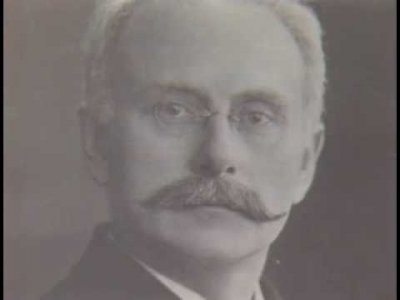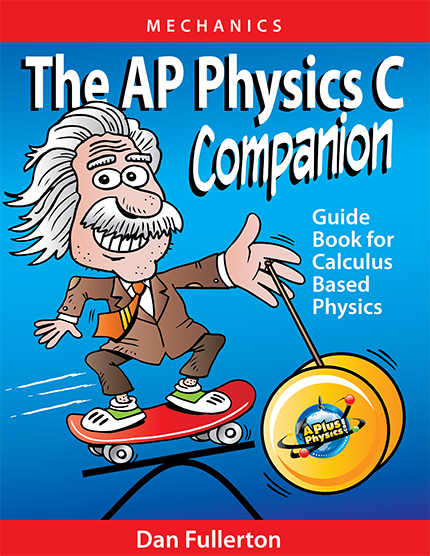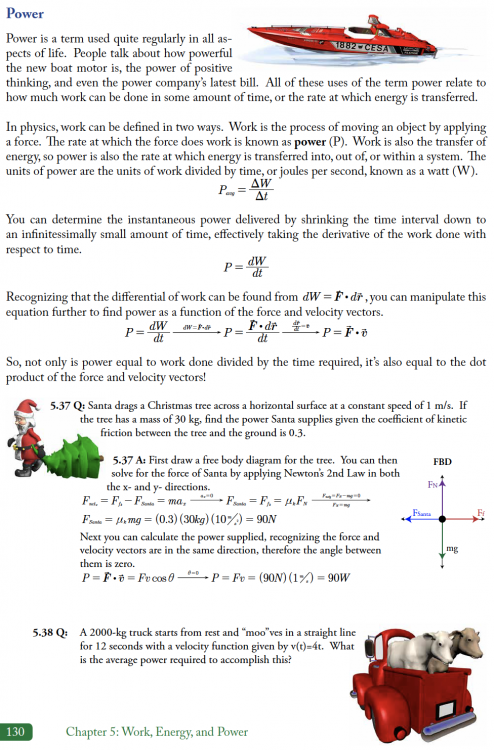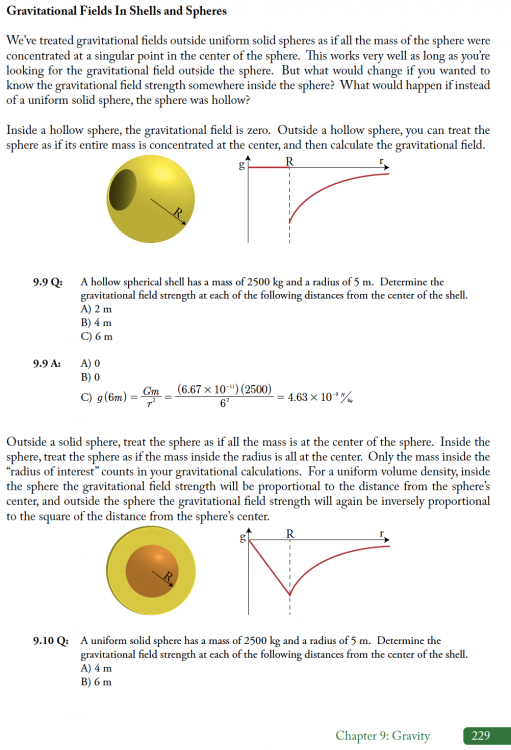-
Posts
2,778 -
Joined
-
Last visited
-
Days Won
49
Content Type
Profiles
Forums
Downloads
Blogs
Events
Store
Posts posted by FizziksGuy
-
-
acts like a wire
-
When the switch is first closed, the capacitor acts like a wire. Both B and D will have no effective resistance because there is a short from one side of the battery to the other where the capacitor is. For a split second, they will have near zero resistance, and a very large spike in current.
-
It depends where on the object that force is being applied.
-
It depends on where you set your reference angle for theta -- I'd defined mine from a perpendicular perspective. You could also have cosine instead depending upon your starting point.
-
Checked:
A) B=D, C, A, E;
 D, B=C, A=E
D, B=C, A=E
There is a typo in an early edition of the book
-
Once the lid pops off, there's no longer a pressure differential holding the lid. Therefore you have 800N up, and 4 N down, for a net of 796 N up.
-
This is a right hand rule question. You'll have to think in three dimensions. As current flows through the wire to the right, a magnetic field is created which travels around the wire. Above the wire (in the air above the book if you're looking at it on paper), the direction of this field is toward the bottom of the page. Below the wire (down into the book if you're looking at it on paper), the direction is toward the top of the page. This relates back to the section on Fields due to Current-Carrying Wires on pages 173-174.
-
To think about this one, recognize there are free charges in the wire (sea of electrons, it's a conductor.) Those charges are moving in a magnetic field. Moving charges in a magnetic field experience a force, which will manifest itself in terms of an electric potential difference.
-
Yup, great catch! Updating...
-
That is a FANTASTIC question, and to answer it, we need to understand that by accelerating at the top position, we're no longer maintaining a circular orbit, but setting up an elliptical orbit. If we increase the speed of the satellite in that top position, we've increased the kinetic energy of the satellite at that position. But a more complete orbital analysis must take into account gravitational potential energy. By increasing the kinetic energy at the top position, we'll trade that speed off for gravitational potential energy at the bottom position. The following web page goes into more detail (https://www.physicsforums.com/threads/orbital-speed-faster-is-closer.733175/), but the best way I've found to get a good feel for orbital mechanics is to play games. As mentioned on the thread above, Orbiter is a free game that will give you a good feel for it, but Kerbal Space Program is a lot more fun in my opinion (though it's not free). :-)
-
Hi Scott,
The PDF book itself isn't printable due to licensing restrictions, however, you can print out all the original worksheets here: http://www.aplusphysics.com/courses/regents/worksheets/ws_index.html. The answer key is only available in electronic form.
-
I'm assuming you're attempting to use v=d/t and coming up with L/t. Recall, though, that this formula gives you AVERAGE velocity.
V_f is equal to 2*average velocity under constant acceleration, which you can provide by:
v_0=0
v=?
d=L
a
t=t
Solve vf^2=v_0^2+2ad to get v_f=Sqrt(2aL)
Solve d=v_o*t+.5*a*t^2 to get a=2L/t^2
Combine those two equations to eliminate a and solve for vf to show vf=Sqrt(4L^2/t^2)=2L/t
-
I'm not sure I completely understand the question, but if I attempt to read between the lines, you're wondering why this isn't the same as a block sliding down a ramp. Recall for the box sliding down a ramp scenario, we're setting the motion of the box along the x-axis and 'tipping' our axes to line up with that motion. In this case, although it looks like a box on the ramp, the car is actually moving into or out of the page, not sliding down the ramp. The direction of its motion is centripetal as it goes around the curve, or directly to the right (along the x-axis)... so we don't tilt our axis in this problem. As the car's motion is along the positive axis, directly horizontal, that remains our 'reference' axis.
-
The AP Physics C Companion - Mechanics
The AP* Physics C Companion - Mechanics is an easy-to-read companion to the AP Physics C: Mechanics curriculum, featuring 350 sample problems with fully worked-out solutions. The AP Physics C Companion: Mechanics covers all major topics of the AP Physics C Mechanics course, including fundamentals of calculus, kinematics, dynamics, work, energy, momentum, rotation, oscillations, and gravity.
The AP Physics C Companion is not a textbook replacement nor is it a strict test-prep guide. It is a short, sweet roadmap to calculus-based physics courses such as AP Physics C: Mechanics and University Physics I, invaluable not just during test prep time, but throughout the entire course. The book lays out basic physics principles as quickly and clearly as possible, then demonstrates their application with hundreds of example problems solved in detail.
Written by a physics teacher, The AP Physics C Companion correlates directly with the APlusPhysics.com website, where you will find free video mini-lessonsexplaining fundamental concepts, detailed study guides, a question and answer discussion board, and most importantly, a meeting place where you can interact with other students from around the world.
This is a license for a digital download of the PDF version for use by one person only on up to five electronic devices. This document may not be printed, edited, re-distributed, re-sold, or licensed to any other user. Once the file has been downloaded no refunds will be given.
-
Submitter
-
Submitted02/14/2017
-
Category
-
-

Name: Mechanical Universe: The Millikan Experiment (12)
Category: Electricity & Magnetism
Date Added: 2017-02-07
Submitter: FizziksGuyEpisode 12. The Millikan Experiment: A dramatic recreation of Millikan's classic oil-drop experiment to determine the charge of a single electron.
“The Mechanical Universe,” is a critically-acclaimed series of 52 thirty-minute videos covering the basic topics of an introductory university physics course.
Each program in the series opens and closes with Caltech Professor David Goodstein providing philosophical, historical and often humorous insight into the subject at hand while lecturing to his freshman physics class. The series contains hundreds of computer animation segments, created by Dr. James F. Blinn, as the primary tool of instruction. Dynamic location footage and historical re-creations are also used to stress the fact that science is a human endeavor.
The series was originally produced as a broadcast telecourse in 1985 by Caltech and Intelecom, Inc. with program funding from the Annenberg/CPB Project.
The online version of the series is sponsored by the Information Science and Technology initiative at Caltech. http://ist.caltech.edu
©1985 California Institute of Technology, The Corporation for Community College Television, and The Annenberg/CPB Project
Mechanical Universe: The Millikan Experiment (12) -
Good Afternoon,
This is designed as a problem to compliment the Regents and Honors programs of study with this website (hence its location in the Regents and Honors folder), in which the coefficient of friction for wood on wood is a given and is designed to be looked up in a reference table (see link below). And yes, the first box would experience friction, however, based on the problem statement, you know the velocity of the first block as it contacts the second block, therefore there's no need to calculate a reduction in velocity prior to impact. Then, following the impact, and knowing the coefficient of kinetic friction of wood on wood, you can solve for the horizontal launch velocity using Newton's 2nd Law, at which point this becomes a projectile problem.
Links to reference table with friction information: http://www.aplusphysics.com/courses/honors/dynamics/friction.html
I would agree, however, that if you didn't know the coefficient of friction, you'd be stuck.
-
Hi Gio. APlusPhysics is just a single person, me, so that's pretty easy to answer. They are on my to-do list, but are at best a month or two away. Note that most of this material is covered to at least some depth in the "Honors" physics video series. Hope that helps!
-Dan
-
 1
1
-
-
Nice outfits! This will be our unit review video next week!
-
From the AP Physics 1 Essentials book... a tricky question.
For B, because you're passing through the zero point, you find the energy going from 3 m/s to 0 m/s, and then the energy going from 0 m/s to -3 m/s, and add them. Same idea with D. It requires you to think past the standard definition and understand what sort of work must be done to accomplish the feat.
-
1 newton = 1 kg*m/s2, so...
1 N/kg = 1 kg*m/(s2*kg) = 1 m/s2
-
Welcome to APlusPhysics -- hope your studies go well this semester!
-
 1
1
-
-
With your kinematic equations. Set up separate vi, fi, d, a, t tables for your two objects, and see what commonalities and relationships you can build based on the given information. Then, solve for vi of the object that starts on the ground (hint -- be careful picking whether you call up or down the positive y-direction. Either will work, but once you pick it, stick with it for the duration of the problem).
-
Conservation of energy is the key here... but much also depends on what assumptions you make (which makes this a GREAT class discussion question). If you assume frictionless, the balls won't roll, and they'll both have the same kinetic energy at the bottom, but B will get their quicker. If you assume there is friction, you can start go get into a great discussion about rolling with or without slipping, which one will roll vs. slide first (or both), and the problem becomes considerably more complicated but is fantastic for reviewing some of the key concepts.
-
One of my favorites!






Phase diagram
In Homework Help
Posted
Google is your friend: http://electron6.phys.utk.edu/101/CH7/phase_transitions.htm